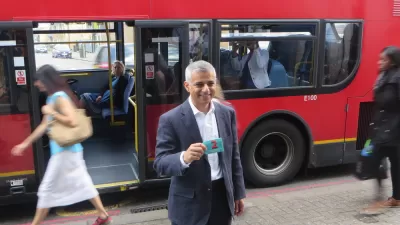Vehicle pollution is making cities around the world unlivable. Some cities have taken steps to curb auto use and emissions, with varying levels of success.

"At a time when most of humanity lives in cities, where do cars belong — especially the old, polluting ones that make city air foul for people to breathe?" ask Somini Sengupta and Nadja Popovich. They examine the efforts in a number of cities to limit and regulate driving as well as what has motivated particular strategies and the outcomes of policy measures.
London was an early adopter of congestion pricing, and the city added additional charges this year in an Ultra Low Emission Zone, which it plans to expand in 2021. "By October 2019, nitrogen dioxide levels in the air had declined by 36 percent compared to February 2017, according to an assessment by the city," note Sengupta and Popovich.
Beijing and New Delhi are two cities that have continued to struggle with poor air quality. Beijing instituted a license plate lottery, among other strategies, and pollution has decreased. "But, the city’s air quality still fails to meet national standards for fine particulate pollution and far exceeds levels the World Health Organization deems safe to breathe," say Sengupta and Popovich.
In New Delhi, measures to address pollution have been hindered by the large increase in the number of motorcycles, cars, and trucks that are belching out emissions, and air quality remains at hazardous levels.
Madrid has faced different roadblocks—namely, political maneuvering playing out around a ban on cars in the city center. Even with measured improvements in air quality, conservatives sought, unsuccessfully, to lift the ban. "The Spanish capital is in the throes of a heated debate about what kind of a city it wants to be, and cars are at the heart of it," write Sengupta and Popovich.
FULL STORY: Cities Worldwide Are Reimagining Their Relationship With Cars

Alabama: Trump Terminates Settlements for Black Communities Harmed By Raw Sewage
Trump deemed the landmark civil rights agreement “illegal DEI and environmental justice policy.”

Planetizen Federal Action Tracker
A weekly monitor of how Trump’s orders and actions are impacting planners and planning in America.

The 120 Year Old Tiny Home Villages That Sheltered San Francisco’s Earthquake Refugees
More than a century ago, San Francisco mobilized to house thousands of residents displaced by the 1906 earthquake. Could their strategy offer a model for the present?

In Both Crashes and Crime, Public Transportation is Far Safer than Driving
Contrary to popular assumptions, public transportation has far lower crash and crime rates than automobile travel. For safer communities, improve and encourage transit travel.

Report: Zoning Reforms Should Complement Nashville’s Ambitious Transit Plan
Without reform, restrictive zoning codes will limit the impact of the city’s planned transit expansion and could exclude some of the residents who depend on transit the most.

Judge Orders Release of Frozen IRA, IIJA Funding
The decision is a victory for environmental groups who charged that freezing funds for critical infrastructure and disaster response programs caused “real and irreparable harm” to communities.
Urban Design for Planners 1: Software Tools
This six-course series explores essential urban design concepts using open source software and equips planners with the tools they need to participate fully in the urban design process.
Planning for Universal Design
Learn the tools for implementing Universal Design in planning regulations.
Clanton & Associates, Inc.
Jessamine County Fiscal Court
Institute for Housing and Urban Development Studies (IHS)
City of Grandview
Harvard GSD Executive Education
Toledo-Lucas County Plan Commissions
Salt Lake City
NYU Wagner Graduate School of Public Service





























